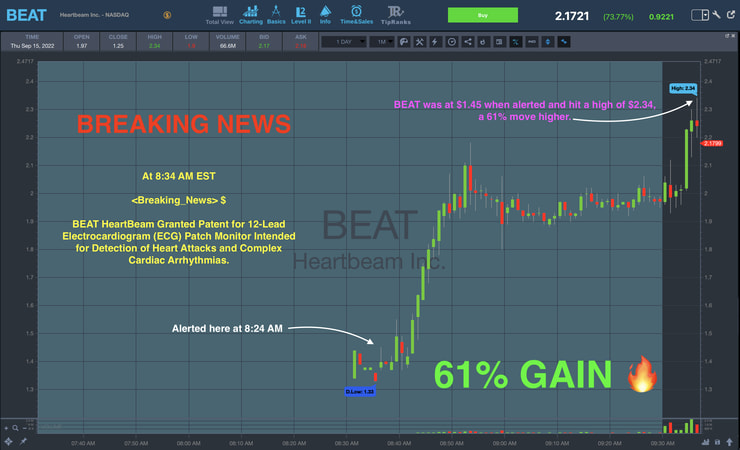When students first join my millionaire challenge, one of the first questions they ask me is…
Tim, where do you find these amazing trade ideas?
Without hesitation, my answer is always the same…
StocksToTrade’s Breaking News Chat Room.
This isn’t meant to be a pitch for these guys. This isn’t meant to be a pitch for these guys. But I would be lying to you if I told you that they weren’t the fastest and the best.
And while there are plenty of ways to make money in the markets…
You could be like Matt Monaco and put your nose to the grindstone for weeks on end to come up with what’s arguably one of the greatest crypto opportunities this year.
The most exciting plays in the market are catalyst-driven, and that’s what the Breaking News chat specializes in.
These guys just have the experience and knowledge to do it better than anyone else.
Just look at this huge runner they alerted on Heartbeam Inc. (NASDAQ: BEAT).
That’s a massive gain before the market even opened!
Now it’s one thing to get these incredible headlines…
But it’s another to actually know how to use them.
So, let me show you what I do with them and give you some pointers on creating juicy setups.
Timing is Everything

Have you ever noticed that many headlines come out at 8:30 a.m. Eastern?
You’re not imagining things.
The vast majority of economic news is released specifically at 8:30 a.m. Eastern.
Companies know this and send out their own press releases around the same time.
By jumbling everything together, they hope traders won’t have the time to read through the details and just assume the news is bullish and buy up shares.
That’s a big reason I recommend our Breaking News Chat room.
These guys have the experience and wherewithal to quickly parse the headlines for the most relevant trade ideas and deliver them quickly.
One of their biggest hits came a few days ago when NeuroBo Pharmaceuticals Inc. (NASDAQ: NRBO) released news just before that critical 8:30 a.m. Eastern mark.
Now, sometimes these alerts can come well into the trading day.
The screenshot below highlights one of the headlines that hit while most folks were probably at lunch.
With any of these news events, you want to ask the following questions:
- Is this information substantial? Earnings provide real insights. A CEO speaking at a conference does not.
- Is it timely? Did the company tell us something new or is it rehashing whatever occurred weeks ago?
- Does anyone care? Are other traders interested in this story?
The last question is an important one.
Not all news events are created equal.
Even important headlines sometimes fall by the wayside.
For a news event to become tradeable I need to see volume and price action.
That means more shares traded with the stock moving higher.
From Headlines to Setups

Want a simple way to trade headlines?
Buy the stock when the news hits with a tight stop.
You’ll probably lose a lot of trades. But every once in a while, you’ll catch a flier that pays a fortune.
However, there’s an easier way to narrow down the field.
Wait for volume and price to increase.
Once you see meaningful price action, you can buy shares against the breakout and see how far it goes?
This can be exceptionally rewarding. But it requires you to be on top of your game and quick on the trigger.
I prefer option number three.
Once a stock makes a sizable move and holds its gains for the day and the next, I can look for a pullback into support on day three early in the morning.
This is what I refer to as a ‘panic dip buy.’
It’s relatively straightforward but looks a little scary.
I watch a basket of stocks that have jumped on news a couple of days before.
Then I wait for a panic sell off into support followed by price action at that level that stops the stock from dropping further.
I buy the stock looking for a bounce back in the other direction of 5%-10%.
I cut the position and move on if it doesn’t happen immediately.
You can see some great examples in this article here.
There are many different ways to work these moves.
I recommend studying them and developing a setup and strategy that works for you.
Then practice with simulated funds until you feel comfortable.
Try to give yourself a trade with small potential losses compared to the possible profits.
Study hard and you’ll find success!
–Tim




Leave a reply